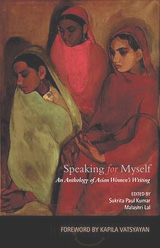
Reaching across the vast landmass that is Asia, which stretches from the Middle East to Japan, and from Russia south to Indonesia, this impressive anthology brings together short fiction and poetry from over sixty authors representing thirty‒four Asian countries. Considering the challenges the editors must have faced in assembling this collection, the fact that the contributing authors are all women makes the anthology all the more impressive. Literature, particularly Western literature, is filled with stereotypes of Asian women, many of them outdated. This collection sets out to challenge such stereotypes and succeeds brilliantly.
I came across Speaking For Myself in a Penguin‒India catalog and was pleased to find the book available globally. I have read many of the books that have been so popular here in the West—novels about meticulously and elaborately costumed Geishas, Chinese women with tiny "lotus‒petal" feet, cloistered and veiled women of the Middle East, or Asian women unhappily bound in arranged marriages. In recent years I have deliberately sought out contemporary literature by Asian women in order to move beyond such restrictive images, and this anthology is part of my journey.
There is such variety in the contributions, that it is difficult to choose favorites. Perhaps listing some of the stories I found most memorable will help to give an idea of the richness of Speaking For Myself.
"The Tomoshibi" by Ariyoshi Sawako of Japan tells a story about three women, the proprietess and two bar maids, working in a small, inconspicuous bar on a busy street.
In "It Has Already Been Late," a very moving story by Nepalese author Maya Thakuri, a young man—a stranger—requests overnight lodging at an old woman's home.
"What the Scar Revealed..." by Zohra Saed of Afghanistan reads like a beautifully told prose poem. "Grandmothers tell the story of healing; how wounds heal only after they have memorized the moment of hurt," it tells us.
Russian author Maria Arbatova's story, "I Am Called a Woman", begins with the ominous line, "Memories of my childhood are full of chilling stories about the witch Baba‒Yaga, while my youth was petrified by the mere utterance of the word—gynaecologist."
The poignant story of a forbidden relationship between two university women is told in "She's a Young Woman and So Am I" by Wong Bikwan of Hong Kong.
In the story "A Girl Called Apple," by Hanan Al‒Shaikh of Lebanon, a young woman who lives with her family on an oasis, refuses to allow her father to raise the red wedding flag that would indicate to others that she is now available for marriage. Even she is not sure why, as she ages, she continues to refuse the posting of the blue flag (for available women in their twenties) and the subsequent yellow one.
The lovely and soulful poem "Woman Wearing Black," by Vietnamese poet Lam Thi My Da, draws the reader into a woman's world with this beginning:
A woman walks down the road
Spring wind drapes her shoulders
She utters one small phrase
Just so she may hear herself
Just so the wind may hear...
There are over seventy pieces in this five hundred plus page anthology which showcases the creativity, strength
and distinctive voices of Asian women from diverse cultural backgrounds. But, while the diversity and
distinctiveness are rich and illuminating, I found that it is often the expression of women's universal concerns
that really reaches out and draws us closer. I highly recommend Speaking For Myself to all who want to
hear the voices of contemporary Asian women speaking for themselves.

Penguin Global, paperback, 9780143065333